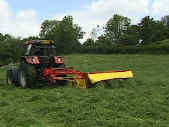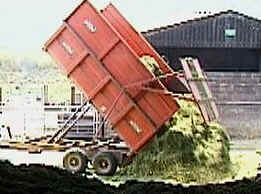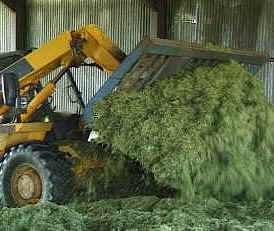 |
> |
 |
> |
|
> |
 |
> |
 |
| MOW | WILT | HARVEST | TRANSPORT | ENSILE | ||||
Mow the grass when the sugar levels are high i.e. In the afternoon. Grass sugar levels are also dependent on the type of grass and the stage of the crop. Ryegrass has higher sugar levels than other grasses, with Cocksfoot having the lowest. |
Wilt the grass just enough to remove excessive moisture or add a chemical inoculant to the harvested crop to aid the ensiling process. |
Use a precision chop harvester to pick up the cut grass and cut it into short lengths. The harvester then blows the grass into trailers. The harvester can be self propelled or powered by a tractor. |
Transport the cut grass to where the silage is to be made. This will usually be in a building, covered yard or sometimes outside on a concrete base. |
Fill the silage clamp as quickly as possible. Each load is
spread thinly and compacted with the tyres of the loading machine so that the air is
expelled. The natural bacterial process which then results is fuelled by the sugars in the
grass. This process pickles the grass, preserving it as silage. |
||||
